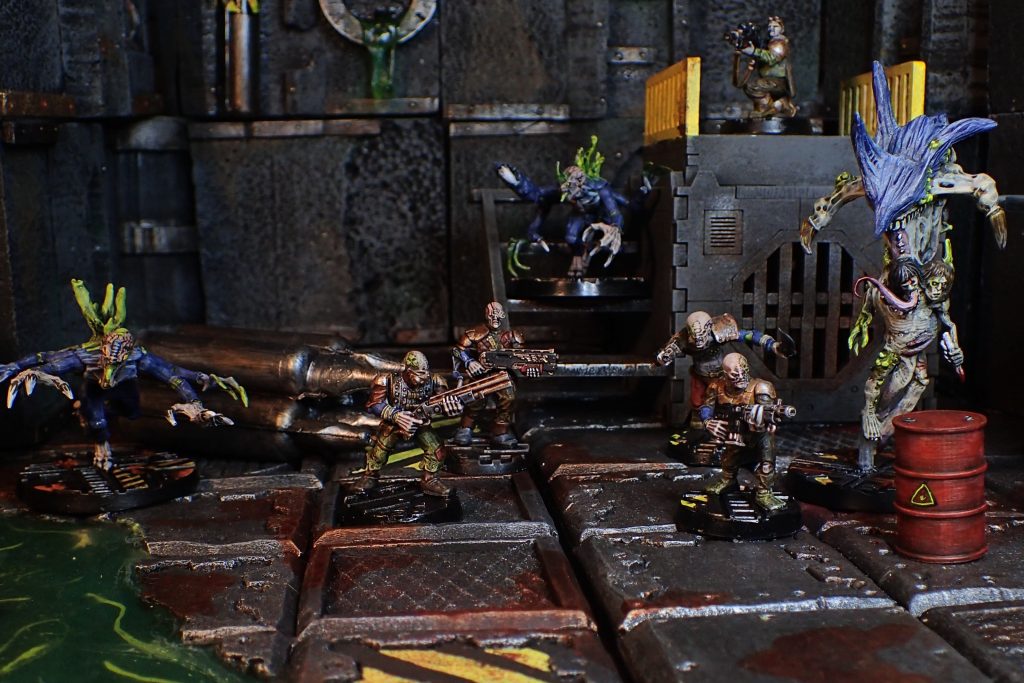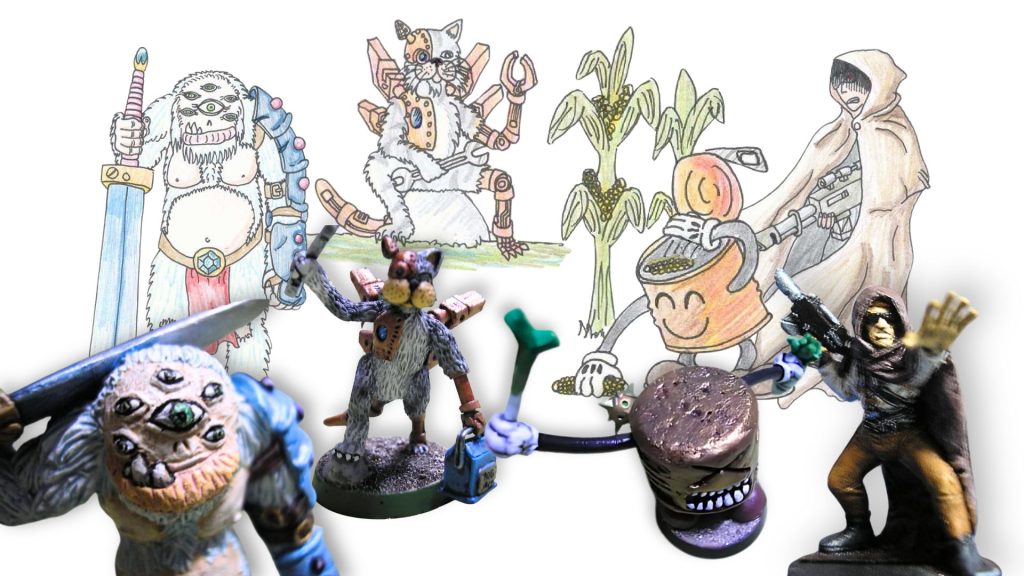Much more than just Warhammer miniatures.
Miniatures are a big part of tabletop games for a reason, they’re not just for decoration. Board game miniatures instantly make a game feel more immersive. It’s easier to picture the action, connect with the characters, and get into the story.
One of the people doing amazing work in this space is Guca Miniatures. If you check out their Instagram, you’ll find all kinds of detailed figures and scenes—from skeleton armies to sci-fi warriors. It’s a mix of creativity, skill, and a real love for the hobby.
Games like Warhammer have had a huge impact on this world. A lot of people who paint or build board game miniatures got started there. It’s more than just a game—it’s what inspired a whole community of creators, including Guca.
How Miniatures Can Level Up Your Game
Miniatures can have a big impact on board game design. Beyond aesthetics, they influence how players understand and interact with the game. A well-designed miniature can instantly communicate a character’s role, status, or personality without needing extra explanation. This improves immersion and helps players connect more deeply with the game world.
Miniatures also offer practical advantages in gameplay. For example, in Warhammer 40,000, the detailed poses and bases of each unit aren’t just decorative—they help indicate line of sight, attack range, and positioning on the battlefield. The fact that miniatures are actual phisicall models on a physical board supports core mechanics like cover, elevation, and movement, turning the game into a really good and visual strategic environment. In this case, the design of the miniatures directly enhances how the game plays and feels.
That way, during development, using miniatures can make it easier to test certain mechanics, especially in games involving combat, movement, or use of space. Designers can spot balance issues or visual confusion early on and adjust accordingly.
Miniatures can also shape the entire identity of a game. Some projects begin with a single sculpt or scene that sets the tone for everything else—the world, the mechanics, even the storyline. In some cases, the look and feel of the miniatures becomes so iconic that they define the brand. Games like Zombicide, Blood Rage, and Descent have used this to great effect.
Some creators even start with a miniature or scene and build a whole game idea around it. That’s how powerful they can be. And some miniatures, don’t think Warhammer, think something much simple like Monopoly, can become an integral defining feature of your game that gets remembered by everyone (you’d much rather be the racing car than the iron).
To inspire designers we got talking with Guiller from Guca Miniatures, who talked to us about his experience getting into miniature design, his workflow, inspirations, and how it can lead to new projects.
Interview with Guca Miniatures

What got you into Warhammer miniatures?
Warhammer was just a step of the journey. Everything started as a kid and with a commercial on TV back in the 90s. My brother and I saw the board game HeroQuest and went running to our parents to convince them to get it for us.
I always liked art as a kid. Spending hours drawing and painting and when I saw the pictures of the miniatures included in the game painted, I knew this was my new hobby. Later on, I just got involved in the miniature hobby, first Warhammer but also other miniature games (Warzone, Chronopia, Confrontation, Carnevale,…).
Do you have a favorite faction or army?
I have too many! But if I had to select one, it would be the undead. Any kind of them. It was my first faction of Warhammer Fantasy and I have always been attracted to the idea of hordes of skeletons and zombies roaming in the darkness.
What advice would you give to someone making a miniatures-focused game?
I think it is essential to value the following concepts: user experience and costs.
In the end, the game mechanics will be the same, being the “tokens” a miniature, a meeple, a card or a standee. What will differentiate one from another are the aesthetics and the cost of the game (in production and retail price).
The development and production of a miniature is much higher than a simple token, card or standee.
But being able to see your own avatar immersed in the board game with all its details is a pleasure that a meeple cannot beat. It also adds value to the product, because the miniatures can be painted and adds hours of joy to the experience.
There are also mid solutions. Some games like “Reventure: Orb tale” provide the option to get resin 3D painted miniatures or allow you to get the STL files to print them yourself, if you are the kind of freak like me that is into miniatures.
How do you decide what scenes to build?
I don’t really have a process. Sometimes it is just an idea popping in my head, and sometimes, staring at a pile of bits and selecting carefully till the idea gets shaped. Though in the end the result may differ a lot from the original plan.
What painting techniques do you use? What tools are essential?
I used to paint with many different techniques. Drybrush, veils, inks, dotted painting, dipping, airbrushes… Currently I just use slap chop due to the lack of time. But still, when I want to invest a lot of time on a piece, I go back to my origins and get the best of every single technique.
Regarding the tools, of course brushes. The feeling of the brush hairs delivering the colour is difficult to be compared with anything.
For scenography and terrain the thermocutter. It was a life changer for me. The capacity to cut hard foam so precisely and without making a mess around is really nice. Also it makes the process much faster.
Do you customize your warhammer miniatures or do kitbashing?
Of course. Kitbashing is really fun! I like to make my own miniatures. Either kitbashing or sculpting with modelling putty.
An example of this is my whole Necromunda gang of Malstrain Genestealers or the competition where I just participated last month: Scumathon25. One of my miniatures I got commended in the category “Hottest hiver”.
What’s been your most challenging or time-consuming project?
Last year I was part of a painting competition called EMINEM (Every Model Is a Necromunda Model), a thematic painting competition based on the game Necromunda. The participants were allowed, and encouraged, to get themes for their entries by rolling dice on different tables with different aspects related with the lore of the game. I rolled on every one of them except for one and I really had to work hard to create something that was so specific and so limited in colours:
- Gang: Xenos
- Theme: Neo noir
- Weapon: “Bet you can’t catch me”
- Extra: Only 3 colors—white, black, red
It really pushed me, but it was super fun and I learned a lot. I also got to meet some amazing creators.
What inspires your style? Movies, books, games…?
Every single creation of dark fantasy or science fiction. Grim dark if possible.
The silence of the space in Alien. The gore and tension of Resident Evil. The classic fantasy of the Lord of the Rings or the inevitable destiny of humanity in Foundation. The stories told in the songs of my favourite Metal bands. The creations of other artists, no matter the thematic.
Do you use tools like Tabletop Creator?
Indeed. Right now I am using it to create supporting tools for my game sessions. For example: Hexagonal tiled campaign map, cards to avoid checking books and rules constantly, tokens… Everything personalised and super easy to make.
Have you ever thought about making a game based on your miniatures?
I would say that It is more the opposite. One of my friends started the idea of a tabletop RPG long ago that evolved with the support of all my friends into long Sunday sessions of playing. Its name was Quarand. If I remember correctly the name came from a random name generator website back then.
Appart of creating rules and running some sessions as master, I sculpted miniatures for all the characters we made for it. Each one of us had our own.
We also made a game similar to Zombicide (quite before it was released) but with hex tiles, where we used all the miniatures I had from Warhammer. Its name was “Braaaainnss!”.

Is there a dream project you haven’t done yet?
Quarand has always been a project that I would like to finish. Get all my friends on board and work on it again. Even if it were not commercial and just a free rulebook, it does not matter.
I imagine it as a board game. As a tabletop RPG. As a video game. As a tabletop skirmish game.
What would you say to someone who wants to get into board game miniatures for the first time?
Never let yourself to be intimidated by the professionals in this hobby. Many are disencouraged when they start and see that their painted/sculpted miniatures are not as good as they expect. But the community is really supportive and will not hesitate to help and
Where can people find you or see more of your work?
Email: gucaminiatures@gmail.com
Instagram: @gucaminiatures


